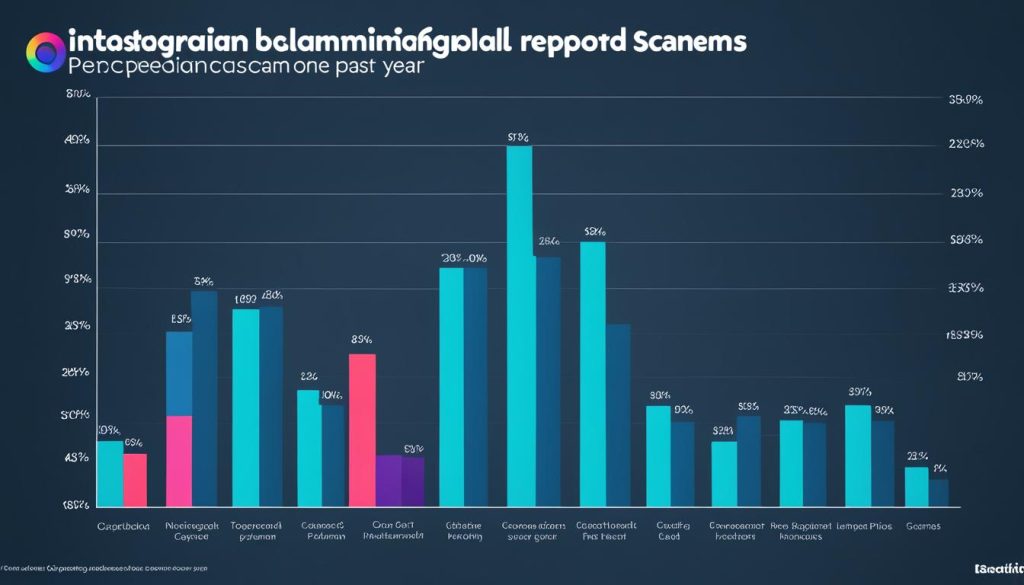As our digital footprints expand on social platforms like Instagram, so does the potential for encountering Instagram blackmail scams. It’s a growing concern that casts a shadow over the digital playground we’ve grown to love. Not only do these scams threaten our online safety, but they also pose significant cyber threats that can compromise personal and financial wellbeing. Understanding the tools and tactics used by nefarious actors is the first step toward reinforcing your privacy protection against these unethical practices. Vigilance and knowledge empower users to navigate Instagram’s social vistas without falling prey to the dark underbelly of online scams.
Key Takeaways
- Recognize the warning signs of Instagram blackmail scams early.
- Empower your online safety by learning about different cyber threats.
- Understand the importance of stringent privacy protection measures on social media.
- Stay informed about the latest tactics used in digital scams and frauds.
- Never underestimate the value of secure practices in safeguarding your Instagram account.
Understanding Instagram Blackmail Scams
As the digital footprint of individuals continue to expand, particularly on social platforms like Instagram, the frequency and sophistication of Instagram blackmail scams have substantially increased. These scams form a segment of online fraud where the perpetrators engage in digital blackmail. They threaten to release compromising information or media of an individual unless their demands—usually monetary—are met.
This insidious form of extortion typically begins with scammers creating plausible scenarios to obtain personal content from the victims. They gradually build a sense of trust, often masquerading as someone with romantic or sexual interests. Eventually, the relationship takes a sharp turn as the scammer uses any obtained compromising material as leverage for blackmail. This section aims to delve into the mechanisms of these scams and provide insights on how they operate, thus preparing users to recognize and respond to such predatory tactics effectively.
- Initiation of Contact: The scammer starts a conversation using a fabricated profile, often adorned with appealing photographs and convincing backstories.
- Trust Building: Over time, through consistent interaction, the scammer establishes a facade of trust and connection, persuading the victim to share personal or intimate content.
- Threat and Extortion: With the compromising material in hand, the scammer begins to threaten the victim with exposure, demanding money or more material under the threat of disclosing the content publically or to the victim’s acquaintances.
It’s imperative for users to stay alert to these machinations. The best recourse upon encountering a potential Instagram blackmail scam is to avoid conceding to demands. Affected individuals should document all communications and seek support from professionals who are skilled in dealing with online fraud and digital blackmail. By understanding the predatory patterns of these scammers, Instagram users can fortify their defenses against such exploitative practices and help safeguard the community at large.
The Anatomy of Online Scams on Social Media
Navigating the digital waters of social media platforms, users must be vigilant against the invasive threats posed by online scams. As cybercriminals constantly develop more cunning strategies to compromise cybersecurity and exploit vulnerabilities, understanding the underpinnings of these scams becomes critical to ensuring internet security. From the lure of counterfeit influencers to the false promises of lucrative returns on investment schemes, these scams are manifold and often sophisticated.
Heightened awareness and education about these tactics are the first line of defense in protecting oneself against identity theft and potential financial loss. Below, we delve into these deceitful practices and the profile red flags that signal potential danger.
Identifying Common Tactics Used By Scammers
Perpetrators of social media scams often don disguises within the digital realm, aiming to mislead and defraud unsuspecting users. Some pose as well-established brands or influential personalities to gain trust. Others may concoct artificial crises or claim to have exclusive access to investment opportunities that promise high returns with minimal risk—classic hallmarks of a scam.
Profile Red Flags: Spotting Suspicious Accounts
Recognition of dubious accounts is pivotal in the fight against fraudsters. Indicators of a suspicious profile that could lead to identity theft include, but are not limited to:
- Accounts claiming affiliation with renowned brands without verification
- Persistent solicitation of personal details or finances under pressure
- Anomalies within follower engagement, where high follower counts don’t match the level of interaction
- Consistent spelling and grammar errors that may reveal a lack of professionalism
- Inconsistencies in narrative or story that throw doubt upon the user’s legitimacy
| Scam Type | Common Tactics | Key Red Flags |
|---|---|---|
| Fake Influencer | Promotion of non-existent products/services | Limited content with high follower count |
| Investment Scam | Promises of high returns with low risk | Urgent calls to action demanding immediate investment |
| Phishing Attempts | Requests for account verification or password resets | Links leading to unsecured or suspicious websites |
| Impersonation Scams | Posing as customer service or support | Unverified accounts using official logos or language |
Remaining informed and cognizant of these stratagems and warning signs is of the essence in reinforcing one’s digital defenses against potential scams. Due diligence, combined with a discerning eye, can significantly reduce the risks associated with the ubiquitous online scams that prowl the social media landscape.
Instagram Blackmail Scams: A Growing Cyber Threat
As part of an unsettling trend, Instagram blackmail scams have emerged as a dominant concern among cyber threats facing social media users. With scammers continuously refining their approach to exploit individuals on popular platforms, awareness and online safety have never been more crucial.

These nefarious actors often craft scenarios of fake emergencies, sending meticulously composed messages designed to create panic and compel immediate action. This can lead to rushed decisions, leaving personal information or finances at risk. Recognizing such ploys is the first step in creating a bulwark against potential emotional and fiscal distress caused by these scams.
- Alertness to unsolicited direct messages
- Reflection before responding to urgent requests
- Verification of a sender’s authenticity through other means
With every report of users falling prey to these sly tactics, it becomes evident that continued education on Instagram blackmail scams is necessary to bolster the community’s defenses against these pervasive cyber threats.
Protecting Your Privacy and Identity on Instagram
In an era where our digital lives are as important as our real ones, privacy protection and internet security have never been more critical. Especially on social networks like Instagram, understanding the importance of online safety is essential to shield yourself from online fraud, digital blackmail, and pervasive social media scams. Here’s how you can fortify your defenses and enjoy a safer online presence.

Implementing Strong Privacy Settings
To curb the risk of Instagram blackmail scams, enhancing your privacy settings is a crucial step. This doesn’t just mean making your account private—it’s about being selective with who you allow to peer into your personal space.
- Switch your profile to Private Mode, restricting unknown users from viewing your content.
- Regularly assess and curate your followers’ list, removing any suspicious accounts.
- Update your password frequently and make it robust—a mix of letters, numbers, and symbols.
- Enable two-factor authentication for an extra layer of security.
Safe Sharing Practices to Prevent Digital Blackmail
While the digital age has made sharing a part of our daily routines, it’s paramount to be cautious about what and with whom we share on social platforms. Your online behavior plays a pivotal role in safeguarding your online safety.
- Be prudent with personal information, even in private messages.
- Remain skeptical of unsolicited communications that demand sensitive data.
- Monitor for unusual account activity that might signal unauthorized access.
- Think twice before engaging with stranger’s messages that seem overly familiar or too good to be true.
| Action | Purpose | Impact on Safety |
|---|---|---|
| Privatize Account | Limits profile visibility | Reduces unsolicited contact |
| Password Updates | Strengthens login security | Prevents unauthorized access |
| Two-Factor Authentication | Adds a security check for logins | Protects against account takeovers |
| Cautious Sharing | Mitigates risk of leaks | Shields against exploitation |
By adhering to these guidelines, you will be far less likely to fall victim to the myriad of threats lurking online. Remember, your best defense on Instagram—and any social platform for that matter—is a strong offense that starts with informed and proactive privacy protection strategies.
Conclusion
In our increasingly connected world, the specter of cyber threats remains ever-present, with online scams like Instagram blackmail continually evolving. It’s imperative for users to stay alert and well-informed about the various forms of deceitful tactics that exist. By recognizing the red flags of dubious profiles and understanding the intricacies of scam strategies, individuals can significantly bolster their privacy protection and maintain internet security.
The digital landscape demands vigilance and an unwillingness to yield to the pressures of online extortionists. Should anyone find themselves targeted by a blackmailer, the best defense is to act swiftly and rationally. Securing the assistance of professionals and reporting the encounter are critical steps in mitigating the damage and holding perpetrators accountable. Adopting rigorous privacy measures, as previously discussed, can greatly reduce one’s exposure to these nefarious activities.
Ultimately, navigating social media platforms safely is achievable. By empowering oneself with the correct knowledge and tools for security, the digital world becomes less daunting. Remember, strength lies in awareness and preparedness, allowing Instagram users to enjoy the platform’s benefits with an increased sense of assurance and control over their online presence.
FAQ
How can I recognize an Instagram blackmail scam?
To recognize Instagram blackmail scams, be wary of anyone who contacts you out of the blue, especially if they quickly progress to requesting compromising photos or personal details. They may also threaten to release this content unless you meet their demands. Watch for sudden changes in conversation, where an individual goes from flattery to threats, and remember that legitimate contacts won’t ask for sensitive information or blackmail you.
What should I do if I’m targeted by a digital blackmailer on Instagram?
If you’re targeted by a digital blackmailer on Instagram, do not comply with their demands or pay them, as this may only escalate the situation. Document all communications for evidence, adjust your privacy settings immediately, report the account to Instagram, seek support from trusted individuals, and contact local law enforcement or experts on internet security to help you navigate the situation.
Online scammers on social media often use tactics such as creating fake profiles impersonating attractive individuals, influencers, or reputable organizations. They may offer fraudulent job opportunities, sponsorships, ‘get rich quick’ schemes, or fake crises that require your immediate financial help. Phishing attempts via direct messages are also common, where scammers try to extract personal information or login credentials.
How can I spot a suspicious account on Instagram?
Spot a suspicious account on Instagram by looking for profile red flags such as a lack of verification when claiming to represent a brand, poorly edited photos, a mismatch between followers and engagement levels, and urgent requests for money or personal details. Be alert to inconsistent stories, and if you identify grammar and spelling errors, it may suggest that the account is not genuine.
How are Instagram blackmail scams a growing cyber threat?
Instagram blackmail scams are a growing cyber threat due to their effectiveness in exploiting personal content for extortion. They capitalize on the vast reach of social media and the relaxed sharing habits of many users. The emotional leverage they hold over victims can lead to significant psychological and financial harm, making them an increasingly concerning issue for online safety.
What steps can I take to enhance my privacy and protection against scams on Instagram to prevent digital blackmail?
To enhance your privacy and protection on Instagram against digital blackmail, set your profile to private, be selective of whom you accept as followers, and think carefully about the information you share online. Regularly update your passwords and use strong, unique combinations. Enable two-factor authentication for an extra layer of security, and educate yourself about the latest scam tactics to stay ahead of potential threats.
Yes, practicing safe sharing habits is essential for preventing online fraud and scams on social media. Avoid sharing personal information, particularly in response to unsolicited requests. Be cautious of anyone who asks for photos, videos, or data that could be used against you. Monitor your account for signs of unauthorized access and remember to think twice before clicking on links or downloading attachments from unknown sources.







